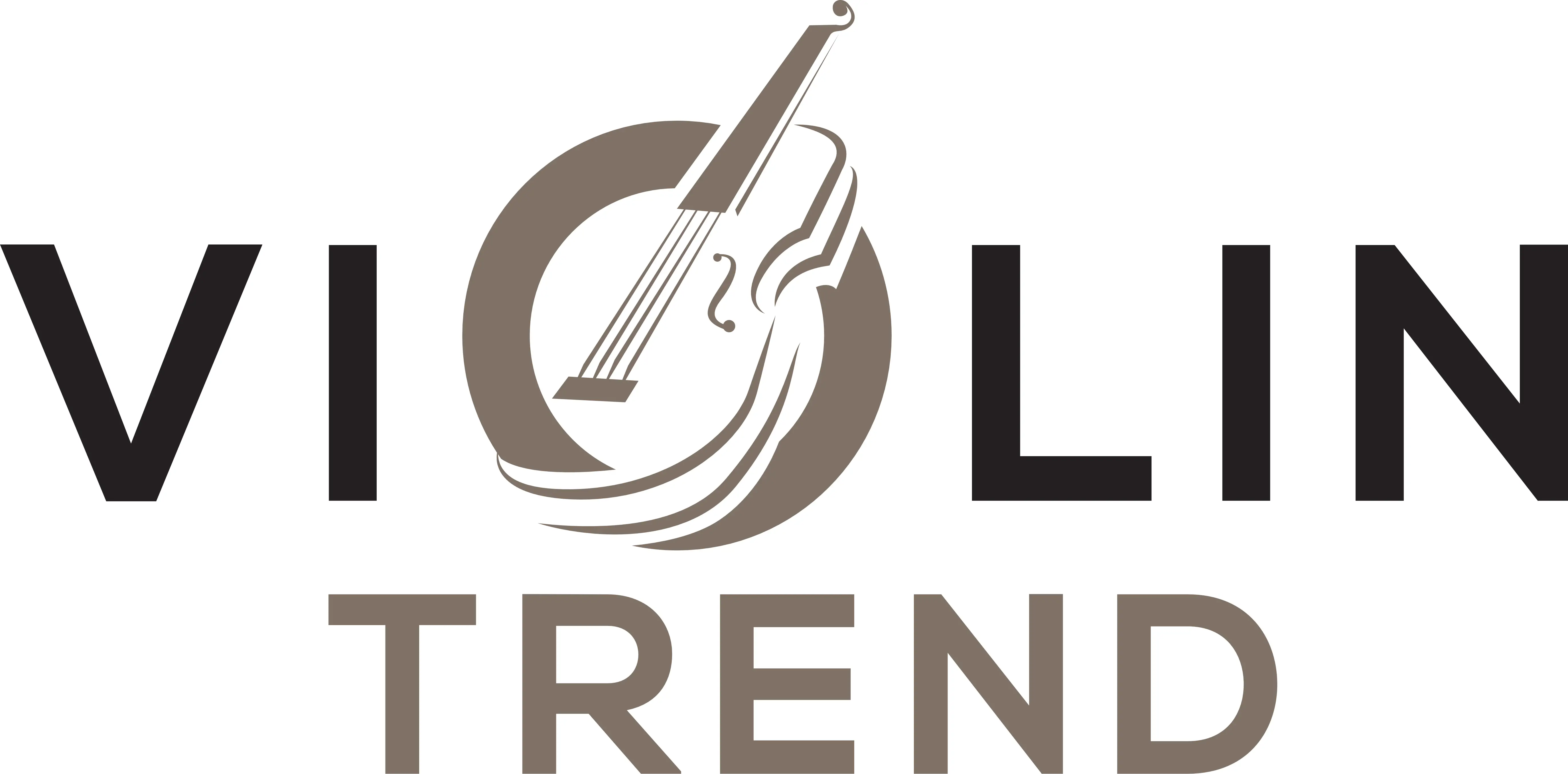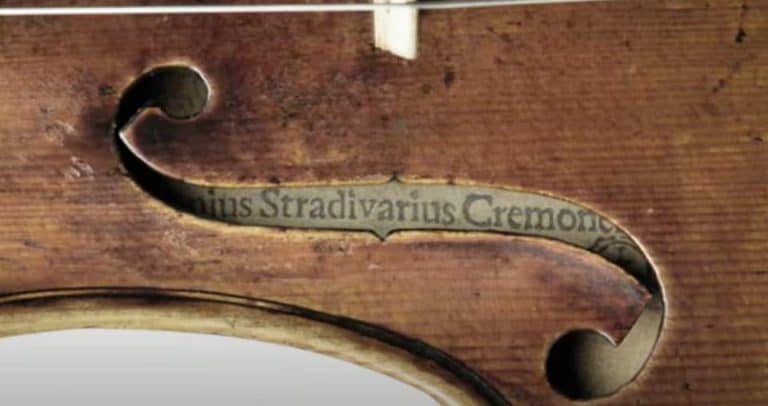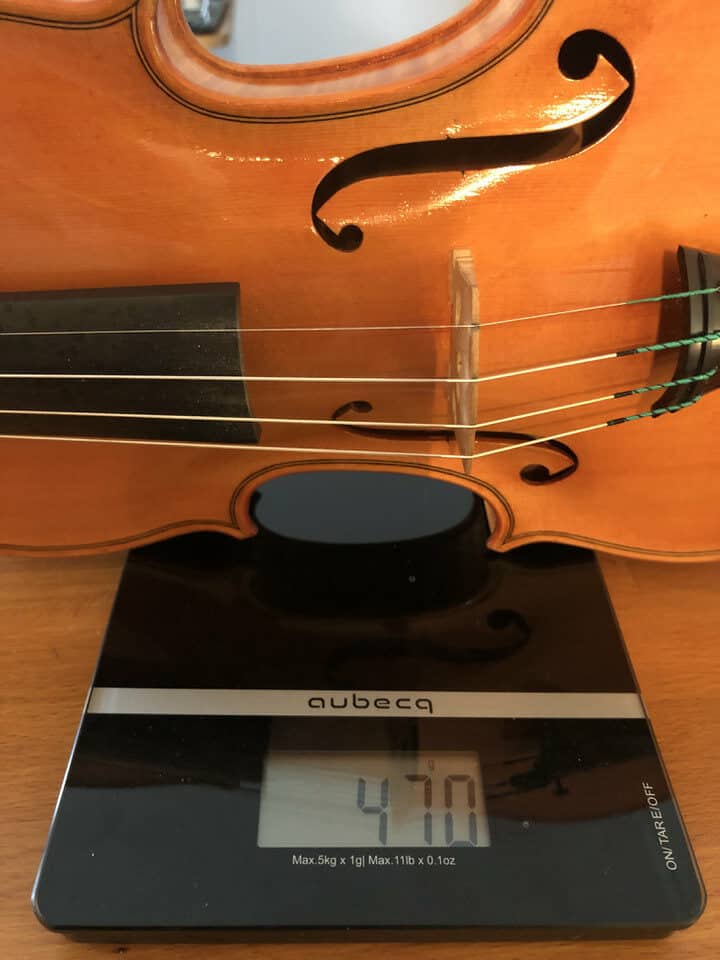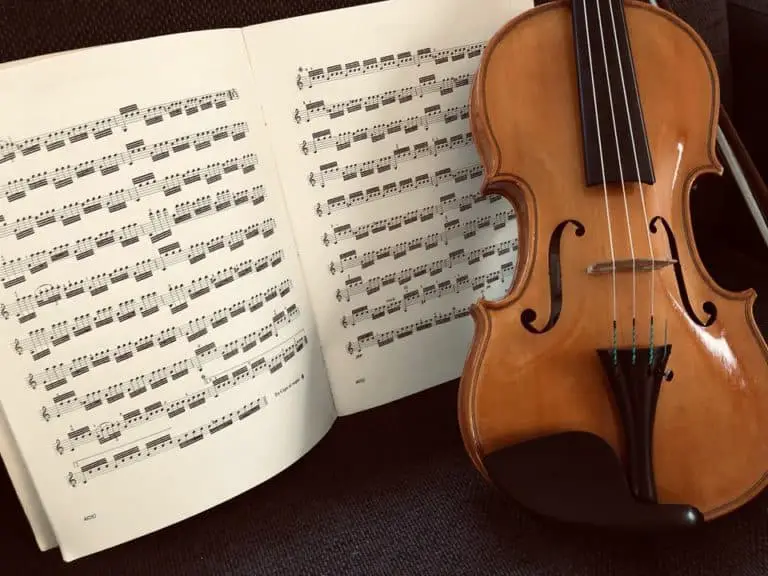How to Play Blues on the Violin: a Beginner’s Guide with Scores
That raw sound, lay-down music, that touches our guts… I am talking about the blues. Blues is mostly associated with the guitar, though, or sometimes piano, saxophone, harmonica… but few people think about the violin in that context. But it is not uncommon to hear the violin playing the blues, except that it is called the fiddle!
If you play an acoustic violin or an electric one for that matter, it is perfectly doable to learn how to play the blues and to broaden your musical culture.
You first need to use the pentatonic scales that correspond to the tonality of the tune. Then, get familiar with the chord changes: for the blues, be reassured, the chords will always be the same: 1 4 1 5 4 1. Then, in the chord progression, emphasize the right notes to the chord (the 3rd for example). Lastly, get great licks to enrich your performance.
It is not difficult to play the blues on the fiddle. But there is some other kind of difficulty to it, for sure. But, by following step by step how I started, more than 30 years ago, I can assure you that this beginner’s guide will have you started in no time.
You will be able to jam with any musician, and that will give you big confidence and freedom. Sharing music and playing together, is what music is all about.
In that guide, I will explain how to play blues in G. Here is a video of me playing a slow blues in G:
Use the right scale: the blues scale on the violin
The minor Pentatonic scale
We are not here to discuss the origins of the blues. It is not the subject of this blog post and might require scholarly work. But all I can say here is that it is not strictly of classical European origin, and, as such, doesn’t use the European classical scale.
The scale used is a scale called pentatonic, which has five tones (Penta meaning five in greek).
There are two mains pentatonic scales in one tonality: the major pentatonic scale and the minor one. Many blues players use both, mix both, but generally speaking the minor pentatonic scale is the one used more often.
In this guide, we will only talk about the minor pentatonic scale. In our case (a blues in G, remember), the G minor pentatonic scale goes as follows:
- G Bb C D F G
- (partition)
You can already hear the blues sound and play that scale on top of an accompanying track. Yes, just played simply like that, it sounds a bit bland or dull. But it is important to get the sound of that scale in your ears. You can already spice it up a little bit by adding rhythm patterns, syncopation, accents like in the example below.
Play the notes in a different order, extract 3 notes arpeggios out of them: the sky is the limit. You would be surprised about how many melodies and phrases can be created with this simple and raw material. Experiment and try out many things with it.
The underlying chords help you understand the sound logic between the harmony and the melody you create. In this example, I have strictly used the minor pentatonic scale: and yet, it seems that the material is more rich and complex. Get familiar with that sound.
Pentatonic scale with spices: the blues scale
You must have already felt that something is missing. Yes, you can play many things with the simple pentatonic scale, but all blues players add other notes to spice it up and add tension to it. This is what we call the blues scale. It is not a scale per se, but it is called that way to simplify the learning process. It basically consists of the pentatonic scale plus two chromaticism notes:
Sheet music
The blues scale has the real sound:
G Bb C C# D F F# G
The added chromaticism gives the scale a blues and jazz flavor to it. Many other possible phrases can be played; our vocabulary is now limitless.
Sometimes the E is added as well, as follows, as a reminiscence of the major pentatonic scale. Just listen to that sound as well:
Bb G E
In this example, I have played on a pedal G, many licks and lines around the G blues scale, with an added E. You can download freely both the score and the musical accompaniment to play it at home. Do not hesitate to have a try. It is by playing, hearing, and feeling that you will learn how to play the blues.
Learn chord changes: to comp or to follow
Now that you have a rich vocabulary with many ideas, you must be feeling that the accompaniment track is always the same. It is simply because what is called a pedal (same note over and over again) is used to build up tension or to practice; it is not a tune.
Blues music is built around chord changes that all sound similar: the same pattern is the universal base of blues.
These chords are (if we call 1 the root): 1 4 1 5 4 1, which translates in G: G C G D C G.
Going from G to C, called plagal in classical music, gives the typical blues sound. The end ( D C G) gives the tension/resolution sound to the tune. And special licks, called turnaround, have to be played there. We will detail that later.
Here is the score with the chord changes detailed:
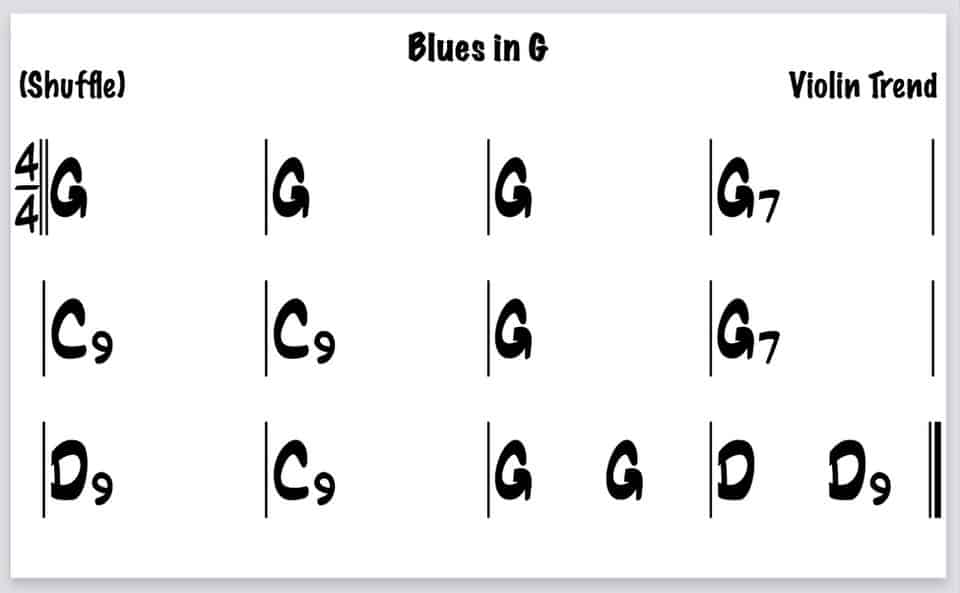
You can download it to print it to play together with the auto-accompaniment track (see below).
On the C and D chords, you still can play the G pentatonic scale. This is where we realize how simple playing the blues can be. But we will detail later what note to emphasize on those chords.
Set a play-along track to practice your scale
Use your favorite auto-accompaniment software such as iReal Pro or Band in Box or download a pre-recorded track with real instruments. Then play the track over and over again to start to feel it and not just follow it.
There are different types of blues, of course, but we can narrow them down to three:
- slow blues (ballad type of blues)
- mid-tempo blues, also known as shuffle,
- fast blues or upbeat.
All different tempos, that is to say, speed, come down with the same structure we detailed above. Of course, there still can be many small tweaks or variations, but for a start, the simple structure is enough.
For this example, we will choose the mid-tempo, Texas shuffle-type blues. This is a well-known rhythm that everyone is familiar with and a great place to start.
You can download here the play-along midi track that I have prepared for you. Please note that midi files are just instructions to your computer/software/soundcard. Midi files (files that have .mid extensions such as the following Blues-in-G.mid) will sound as good as your software will be able to play them. If you are not pleased with the quality, please download the mp3 file below:
You can loop this track and play the pentatonic scale, the blues scale. Keep on improving and experiment with what comes to your mind.
What notes to emphasize
Now that you have a complete track and that you are starting to know and feel your pentatonic and blues scale, you can start to improvise.
But you must be feeling that what you play sounds a bit bland.
It is because there should be logic in your phrases. Even the most obscure blues players have a way of phrasing that emphasizes the chord changes they play on. Sure, you can play want you want, what you feel, but to a certain extent.
Remember, the chords are 1 4 1 5 4 1, or, in G, G C G D C G.
That means that, on each chord, there are notes that are preferable to emphasize usually by the means of accents or finishing the phrase on them. There are no notes completely to avoid, you just can pass over them.
- In G, the notes to emphasize is the third (Bb), major third (B), The Fifth (D), the C (fourth) is to avoid or passed over,
- in C, the note to emphasize is the third (E), the root (C), the note to avoid is the fourth (F)
- in D, the chord is called dominant and has to resolve into the G. Usually blues players have a more complex phrase on this chord called the “turnaround”. But you can simply emphasize the following notes from the G pentatonic scale: F (third), D (root), C (7th).
If you stay longer on these notes, put dynamic accents on them, you will start to hear logic. Not everything sounds the same anymore. What you play underlines the harmony, which, in return, values the solo.
Learn the blue note and quarter tones
It is not a beginner trick anymore but, hey, why not. An important note to play, to emphasize, is called the blue note and has some mystic to it. It is the augmented fourth, 4+, or in G it is C#. The following phrase: C# C Bb G is one of the most well-known sounds of Blues.
Many players use and abuse this note in many manners. Play around with it. Make the most out of it: it is magical and mysterious. It gives a great sound to the tune.
One way to use the blues note is to understand that it is not a plain C# in tune. All right, this is not, once again, a beginner’s tip, but I am sure you will understand it, or at least hear it. It is a concept of quarter tones. In two sentences: notes are a whole step apart, or half a step apart. This is how western classical music has divided the common scale. But it can be otherwise. There can be other types of intervals: half-half steps (quarter tones) are even closer together. When you hear them, you may not understand what they are, but you can surely feel them.
For sure, blues players use quarter-tones a lot, that is to say – a C # flatter, more close to C (playing around the blue note);
- a Bb tending to B, a flatter major third,
With these simple tricks, difficult to apprehend maybe, but easy to hear and execute, your solos will sound a lot better.
Especially with the following concept.
Learn to slide
Blues musicians have a special way to play or to sing. Blues guitar players have created, invented somehow, what they call string bending: instead of playing regular notes following one another in a piano-like fashion, they emulate the sliding effect of a human voice. Indeed, the human voice sings but also screams and shouts.
That is something we can emulate on the violin: we need to learn how to slide. This is not difficult to do, especially if we focus again on the interesting notes we need to emphasize: the blue note and the third.
Learn to do these slides:
- C# C Bb, or in that vein: C C# D / D C# C,
- Bb B
Now THAT sounds tasty. The violin sounds like a voice, like a guitar or a harmonica. It becomes a band. But it is not over yet. Let’s see where we can go from now.
Learn some licks

Now that you have the base to play blues on the violin, what you need to do is to get familiar with the sound, the phrasing of this great music. For that, you surely need to listen to a lot of blues music, on all instruments. Not only the violin, of course, as there are not many blues violinists. But also pianists, singers and especially maybe guitarists.
Pick up a couple of licks, here and there, to enrich your playing and your overall vocabulary. You will that what we call the turnaround phrase, D C G at the end of the changes, is the spicy part of a solo. There are many of them and can be a signature for a player. You can tell BB King for his turnaround phrases, and surely as well, Albert King or SRV. Now listen and play, play on top of old records from the masters and emulate their phrasing. But that is another story.
k out my article on how to start to improvise on the violin. It is a great complement to this one.
The gear and products I use and recommend for my electric violin
First, If you want to hear your electric violin, you need to either use headphones, plug it into an amp, or an audio interface.
The small amp I use and recommend if you want to practice at home is the great Yamaha THR10 from the THR series. It is portable and not expensive, easy to use and set up.
If you want to record yourself or plug your violin into headphones, your laptop, or your phone, a good and cheap digital audio interface I can recommend is the iRig HD2, which is more and more affordable on Amazon.
I typically use Thomastik Dominant strings on my electric violin. They come quite cheap on Amazon considering their quality and sound. Synthetic core strings work well on Yamaha electric violins.
Lastly, I use mainly Dominant rosin as well on my electric violin, as it has been designed to go with Dominant Strings.
You can check out in detail all the stuff I have tested and used on my recommended product page where I go into more details.
